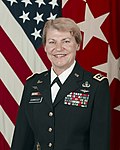Top Qs
Timeline
Chat
Perspective
United States Army Materiel Command
U.S. Army's primary provider of materiel From Wikipedia, the free encyclopedia
Remove ads
The United States Army Materiel Command (AMC) is the primary provider of materiel to the United States Army.
AMC operates depots; arsenals; ammunition plants; and other facilities, and maintains the Army's prepositioned stocks, both on land and afloat.[3] The command is also the Department of Defense Executive Agent for conventional ammunition and the U.S. chemical weapons stockpile.
AMC is responsible for the business of selling United States Army equipment and services to allies of the United States and negotiates and implements agreements for co-production of U.S. weapons systems by other states.
Remove ads
History
Summarize
Perspective
AMC was established on 8 May 1962, and was activated on 1 August of that year as a major field command of the U.S. Army. Prior to its creation, Lt. Gen. Frank S. Besson, Jr. directed a Department of the Army study to be conducted, of which recommended the creation of a "materiel development and logistics command". He would serve as the AMC's first commander.
As part of the formation of AMC, various field activities and installations were transferred into it. Most of those field activities and installations came from six of the technical services, including: the Chief Chemical Officer, Chief of Engineers, Chief of Ordnance (the single largest source of AMC installations), the Quartermaster General, Chief Signal Officer, and the Chief of Transportation.[4] The seventh technical service, the Surgeon General, provided one medical depot. Several other installations and activities came from Headquarters, Department of the Army (HQDA) Deputy Chief of Staff for Logistics, the Continental Army Command (CONARC), and the Chief of Research and Development.
Since its creation in 1962, AMC underwent constant reorganizations in its headquarters and field commands. These conditions reflected a more fundamental problem, chronic dissatisfaction with the Army’s entire system for developing and fielding new weapons and equipment. A special Army Materiel Acquisition Review Committee, on 1 April 1974 recommended sweeping organizational and management reforms.[5]

On 23 January 1976, AMC was renamed to U.S. Army Materiel Development and Readiness Command (DARCOM). DARCOM commander Gen. John R. Deane Jr. best summed up the renaming's purpose, which was "to emphasize that readiness is a part of our business."[6][7]
Both "materiel development" and "materiel readiness" represented two major organizational elements within the command. The former, materiel development, was responsible for research and development, producer tests and evaluation, and initial procurement of weapons and equipment. The latter, materiel readiness, was responsible for buying, fielding, and maintaining those systems.[5]
As part of this reorganization, commands managed by AMC were broken into individual commands for research and development, and for readiness.[6][7] Accordingly, during fiscal year 1976 the Tank-Automotive Command (TACOM) became the Tank-Automotive Research and Development Command and the Tank-Automotive Materiel Readiness Command. The Missile and the Armaments Commands were similarly divided.[5]
Effective 1 August 1984, DARCOM was renamed back to AMC. The reason for the change was to "remove a perceived boundary between development and logistics support implied in the DARCOM name". Additionally, it was said that the conciseness and clarity of the name AMC "[would] be better understood by allies and the general public."[7]
In December 2024, Army Secretary Christine Wormuth, "in a dramatic and rare move," dismissed General Charles R. Hamilton, the AMC commanding general, following an Army investigation that concluded he had improperly intervened to arrange a battalion command position for a female lieutenant colonel he favored.[8]
Remove ads
Locations
AMC is currently headquartered at Redstone Arsenal in Huntsville, Alabama, and has operations in approximately 149 locations worldwide including more than 49 American states and 50 countries.
AMC employs upwards of 70,000 military and civilian employees.
From 1973 to 2003, AMC was headquartered in Alexandria, Virginia, and prior to 1973, it was headquartered at what is now Reagan National Airport.[9] AMC was located at Fort Belvoir, Virginia, between 2003 and 2005 before being relocated to Alabama by the 2005 Base Realignment and Closure Commission.
Remove ads
List of commanding generals

Remove ads
Organization
Summarize
Perspective
The Army Materiel Command oversees 10 major subordinate commands (MSC) and two separate reporting activities (SRA).[13][14][15]
Current
Major subordinate commands
 U.S. Army Aviation and Missile Command
U.S. Army Aviation and Missile Command U.S. Army Communications-Electronics Command
U.S. Army Communications-Electronics Command U.S. Army Contracting Command
U.S. Army Contracting Command U.S. Army Financial Management Command, a former direct reporting unit to the Department of the Army, made subordinate to AMC, effective 1 Oct. 2019.[16]
U.S. Army Financial Management Command, a former direct reporting unit to the Department of the Army, made subordinate to AMC, effective 1 Oct. 2019.[16] U.S. Army Installation Management Command
U.S. Army Installation Management CommandU.S. Army Joint Munitions Command
 U.S. Army Security Assistance Command
U.S. Army Security Assistance Command U.S. Army Sustainment Command
U.S. Army Sustainment Command U.S. Army Tank-automotive and Armaments Command
U.S. Army Tank-automotive and Armaments Command U.S. Army Transportation Command
U.S. Army Transportation Command- See also: U.S. Army Medical Materiel Agency (a Life Cycle Management Command – LCMC, but subordinate to MRDC)
Separate reporting activities
 U.S. Army Chemical Materials Activity, activated as the Chemical Materials Agency in 2002 (an AMC major subordinate command), was redesignated to "Activity" and became an AMC separate reporting activity in 2012.[17]
U.S. Army Chemical Materials Activity, activated as the Chemical Materials Agency in 2002 (an AMC major subordinate command), was redesignated to "Activity" and became an AMC separate reporting activity in 2012.[17]- U.S. Army Logistics Data Analysis Center
Former units
Major subordinate commands
 U.S. Army Industrial Operations Command, former structure of Joint Munitions Command, from 1995 to 2000.[18][19]
U.S. Army Industrial Operations Command, former structure of Joint Munitions Command, from 1995 to 2000.[18][19] U.S. Army Research, Development and Engineering Command, as designated from 2002 to 2019.[20]
U.S. Army Research, Development and Engineering Command, as designated from 2002 to 2019.[20]
 U.S. Army Combat Capabilities Development Command – RDECOM redesignation upon transfer to Army Futures Command, effective 3 Feb. 2019.[21]
U.S. Army Combat Capabilities Development Command – RDECOM redesignation upon transfer to Army Futures Command, effective 3 Feb. 2019.[21]
 U.S. Army Medical Logistics Command, activated in 2019 as an AMC major subordinate command, and in 2020, transferred under the Communications-Electronics Command.[22][23]
U.S. Army Medical Logistics Command, activated in 2019 as an AMC major subordinate command, and in 2020, transferred under the Communications-Electronics Command.[22][23]
Separate reporting activities
 U.S. Army Element, Assembled Chemical Weapons Alternatives, an Army "element", assigned to AMC but reporting to the DoD, was designated a program executive office (PEO) and assigned to USAASC in 2012.[24]
U.S. Army Element, Assembled Chemical Weapons Alternatives, an Army "element", assigned to AMC but reporting to the DoD, was designated a program executive office (PEO) and assigned to USAASC in 2012.[24]
Remove ads
See also
Comparable organizations – Other U.S. Armed Forces systems commands
References
References
External links
Wikiwand - on
Seamless Wikipedia browsing. On steroids.
Remove ads

























